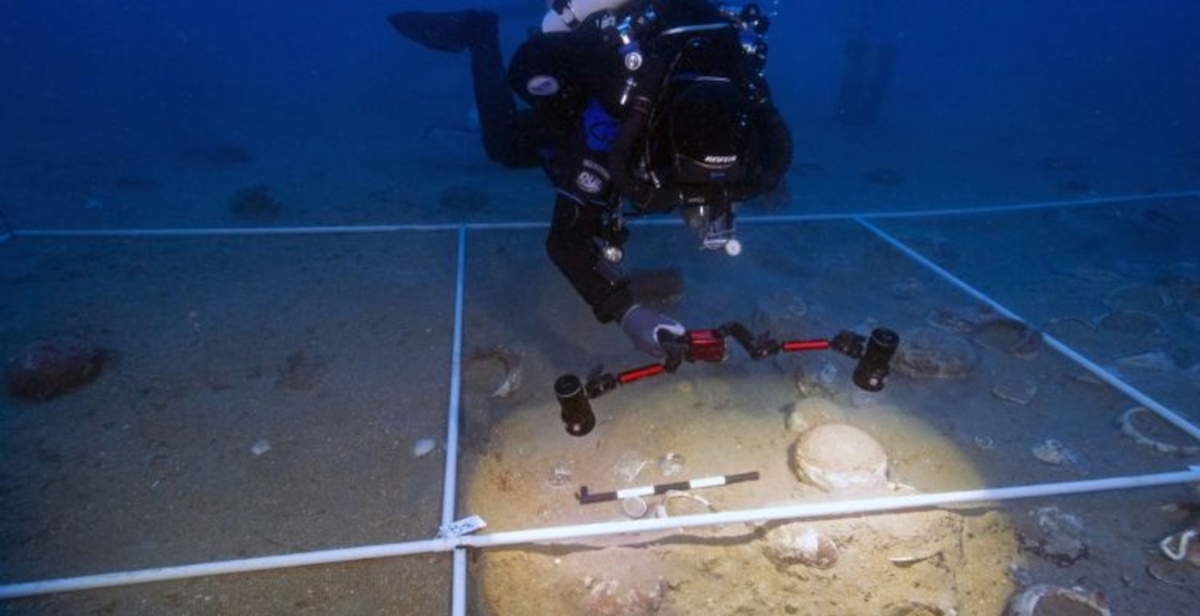Research conducted on the Late Antique wreck found in 2019 on the seabed of Marina di Ognina, Syracuse, adds new elements to the understanding of one of the most relevant underwater sites identified in recent years in the Mediterranean. The study mission Relitto delleOlle, named for the type of some ceramic containers recovered on board, allowed scholars to more accurately define the orientation of the vessel and the proportions of its cargo. Cross-analysis of the data collected in the dive and the three-dimensional documentation of the site now offers a more coherent picture of the vessel’s original dimensions and its commercial function. According to initial assessments, the vessel appears to be compatible with a medium-sized cargo ship. Estimates indicate a length between 15 and 18 meters and a width between 5 and 6 meters. The definition of these parameters was made possible by a combination of a high-resolution photogrammetric survey and an initial phase of stratigraphic cleaning of the sediments that covered the cargo. The intervention led to the emergence of a substantial number of artifacts, coupled with useful information to clarify the internal organization of the hold.
“Thanks to modern and sophisticated equipment, we are continuing in the groove of scientific research,” said Cultural Heritage and Sicilian Identity Councillor Francesco Paolo Scarpinato, “these are useful operations to clarify the typology and chronology of the vessel, as well as to better understand the nature of the cargo and the dynamics of the sinking.”
"The Olle Wreck presents itself as a site of extraordinary potential, still rich in information that is not immediately perceptible," explained Superintendent of the Sea Ferdinando Maurici. “The cargo, which is extremely homogeneous, has fortunately come down to the present day in optimal condition, having not suffered significant alterations, nor damage due to the passage of trawls or clandestine interventions.”
During the most recent dives, two new artifacts emerged: a second single-handed acromo vessel with a kettle function and a double-handed acromo olla equipped with a lid. Their recovery expands the typological series of materials already identified and helps paint a more articulated picture of the goods transported. The ceramic finds documented so far belong to more than one morphological variant and are organized in different modules, a circumstance that suggests careful planning of the cargo arrangement. One of the still open questions concerns the preservation of the ship’s wooden structure. The very few traces of wood recognized so far show how the degradation of the material is advanced, yet scholars speculate that important elements of the hull may have been preserved beneath the cargo.

The mission’s next goals aim precisely at a complete delineation of the deposit, an essential step to obtain a more precise estimate of the vessel’s original dimensions and to check for any structural portions still intact. The fieldwork was coordinated by the Sicilian Region’s Superintendence of the Sea, which is responsible for the scientific direction of the operations. The underwater activities were supported by divers from the Capo Murro diving center in Syracuse, who provided assistance and nautical means, and by deep-sea divers from Global Underwater Explorers (Gue). The photogrammetric survey was supervised by Luca Palezza and Eduardo Salaj, while the biological analysis of the site was conducted by Linda Pasolli. Cristiano Rosa oversaw the design and implementation of the operational equipment. The general supervision of the dive operations, organized and coordinated by Fabio Portella, was entrusted to Ninny Di Grazia.
The history of searches related to the Ognina wreck dates back to 2019, but the first reports date back to six years ago, when honorary inspector for underwater cultural heritage Fabio Portella and Stefano Gualtieri spotted some anomalies on the seabed during a reconnaissance dedicated to mapping Pirelli telegraph cables laid in the late 19th century. The area is about a mile off the Syracuse coast, at a depth of 70 meters, a condition that from the beginning required specific skills and adequate equipment to operate safely. In 2021 the main core of the deposit was identified, preliminarily datable between the fifth and sixth centuries AD, consisting of a large quantity of ceramic containers organized in four distinct modules and lids belonging to three formal variants. Following the report to the Superintendence of the Sea, the recovery of a first group of finds considered strategic for the characterization of the site was authorized: two ollae, three lids and a single-handled kettle. These materials offered the first concrete data on the type of cargo and the possible function of the vessel, paving the way for the mission underway today.
 |
| In Syracuse new analysis of Ognina wreck reveals ship's size and cargo |
Warning: the translation into English of the original Italian article was created using automatic tools. We undertake to review all articles, but we do not guarantee the total absence of inaccuracies in the translation due to the program. You can find the original by clicking on the ITA button. If you find any mistake,please contact us.